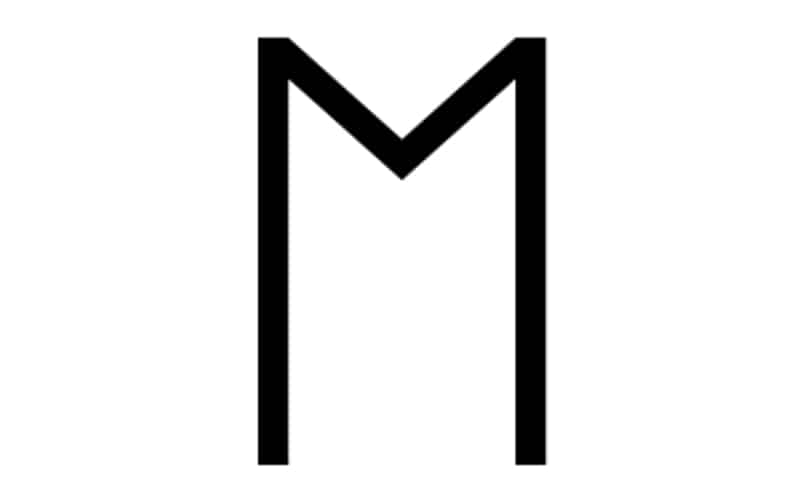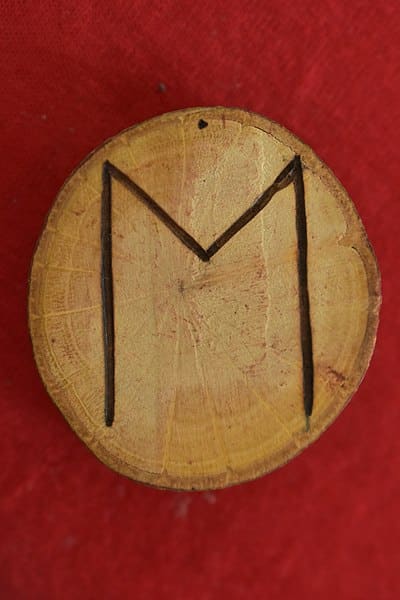Imagine, if you will, a time when the clatter of hooves echoed through the valleys of Scandinavia. A time when the bond between a Viking and his horse was as sacred as the runes themselves. Among these runes, one symbol stands out – Ehwaz, the horse rune.
Now, picture a Viking warrior, his hand resting on a runestone etched with the Ehwaz rune. The stone is cold, but the symbol it bears is one of warmth and companionship. This is our destination, the world of the Ehwaz rune, a symbol as steadfast as the horse it represents.
Ehwaz: Background and Description
The Elder Futhark, the oldest form of the runic alphabets, is a system of writing steeped in mystery and magic. Its origins trace back to the 2nd to 4th centuries, with evidence found on artifacts like the Kylver Stone from Gotland, Sweden. The Ehwaz rune, the nineteenth in this ancient alphabet, sits between Berkanan, the rune of Fertility, and Mannaz, the rune of humanity. Its name, derived from the Proto-Germanic word ‘ehwaz’, means ‘horse’.
As the Elder Futhark evolved into the Younger Futhark, around the 8th century, the number of runes was reduced, but Ehwaz retained its place. Its enduring presence speaks volumes about its significance in the Viking Age. The horse, after all, was a vital companion in the harsh Nordic climate.
Graphical Representation

The Ehwaz rune is a simple yet powerful symbol. Picture two vertical lines, connected by an inverted point at the top, like two horses yoked together. This is the essence of Ehwaz, a symbol that captures the partnership and trust between a rider and his horse.
Over time, variations of the rune have appeared. Some versions depict it as a single vertical line with a diagonal line branching off towards the right. Despite these variations, the core symbolism remains unchanged – a symbol of partnership and trust.
Phonetic Value
In the Proto-Germanic language, the Ehwaz rune represented the ‘e’ sound. As the Germanic languages evolved, this phonetic value remained consistent. Whether in Old Norse, Old English, or Old High German, Ehwaz continued to be associated with the ‘e’ sound, further cementing its connection to ‘ehwaz’, the horse.
Symbolic Meaning of the Ehwaz Rune
The Ehwaz rune is a symbol of partnership, trust, and journey. Its Proto-Germanic translation, ‘horse’, encapsulates its essence perfectly. The horse, after all, is a creature of companionship and service. It’s no surprise then that Ehwaz is often associated with the journeying god, Odin.
In the Viking Age, the horse was more than just a beast of burden. It was a trusted companion, a partner in the journey of life. The Ehwaz rune, with its connection to the horse, reflects these deeply ingrained cultural beliefs.
The Aett and its Symbolism
The rune belongs to Tyr’s aett, one of the three groups of runes in the Elder Futhark. Each aett is associated with a specific Norse god or goddess, and in this case, it’s the brave warrior, Tyr.
Tyr’s aett is a collection of runes that embody themes of courage, justice, and balance, much like Tyr himself, the god of law and heroic glory. The Ehwaz rune, with its symbolism of partnership and journey, fits perfectly within this aett. It’s a symbol of the mutual trust and respect that are essential in any partnership, much like the balance Tyr upholds in the Norse pantheon.
The aett system is a crucial part of understanding the Elder Futhark. It’s not just about individual runes, but how they interact and relate to each other within their aett. The Ehwaz rune, as part of Tyr’s aett, carries the warrior god’s sense of justice and balance, guiding us on our journey with its steadfast energy.
Elder Futhark Quiz
Do you want to test your knowledge of Elder Futhark runes? Then this quiz is perfect for you!
Don’t forget to play our other games as well!
Ehwaz Used in Divination and Magic

Now, I must confess, I’m not one for divination or magic. But I can’t deny the fascination these practices hold for many. In runic divination, the Ehwaz rune is seen as a sign of partnership, progress, and journey.
Its association with the horse made it a powerful symbol for invoking trust, companionship, and progress. While we can’t say for certain how the Vikings used Ehwaz in their spells, its symbolic meaning offers some intriguing possibilities.
Frequently Asked Questions
The Ehwaz rune symbolizes partnership, trust, and journey.
The Ehwaz rune belongs to Tyr’s aett in the Elder Futhark.
People see Ehwaz as a sign of partnership and progress in runic divination. Likely, practitioners used it in magic to invoke trust and companionship.
Featured Image Credit: BK, Public domain, via Wikimedia Commons
